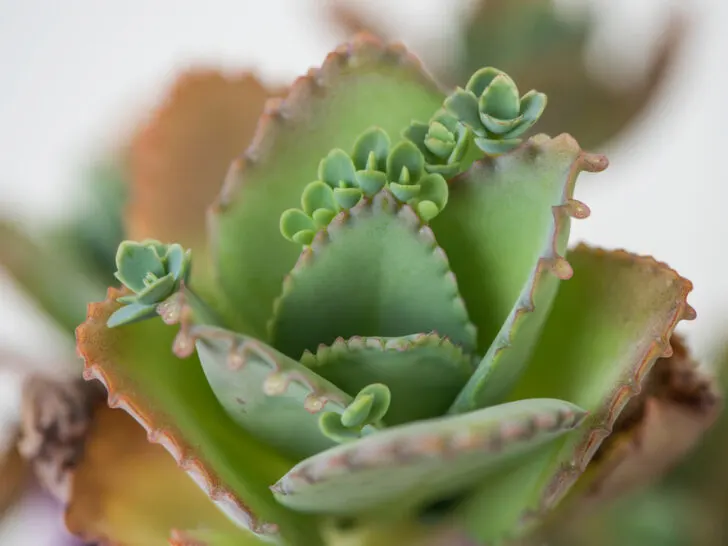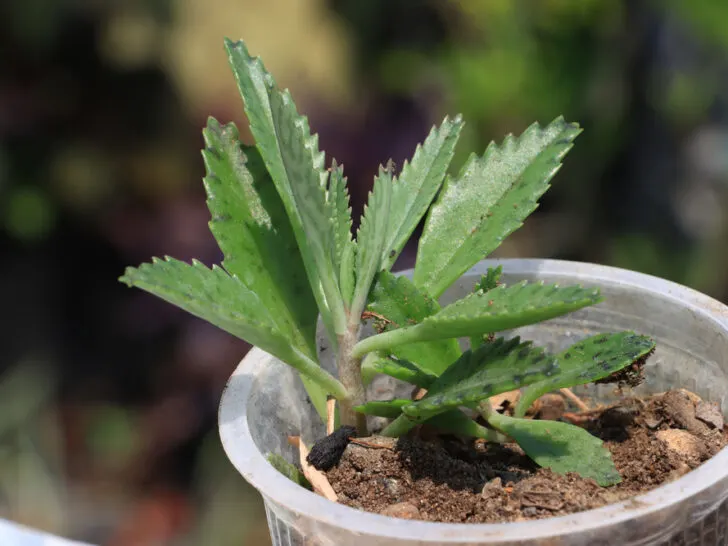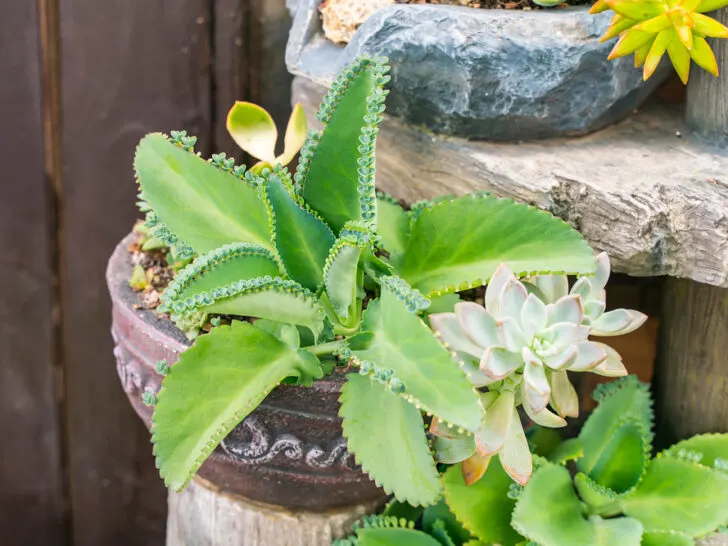
The Alligator Plant (Kalanchoe daigremontiana) is also called the devil’s backbone, mother of thousands, or the Mexican hat plant. It’s a unique, hardy plant that’s simple to care for. It’s certainly one that every plant owner should have in their collection.
The Alligator Plant is a drought-tolerant succulent with long, pointed leaves that have small divots along each leaf’s edges. These divots can be pruned and rooted to propagate. The plant blooms from the center, so its plumage makes the leaves look like an alligator’s mouth, hence the name.
The Alligator Plant isn’t too demanding and can survive many years. If you’re looking for another easy-going plant to add to your collection, this article is for you. Keep reading to learn how to care for an Alligator Plant properly and how to propagate one.
How To Care for an Alligator Plant

Like all succulents, Alligator Plants need three basic necessities to survive:
- Rich, well-draining soil
- Adequate water
- Bright, indirect sunlight
But the question is, how much of each should they receive? Let’s take a look.
Water It Thoroughly Every 14 Days
The Alligator Plant is drought-tolerant, meaning it can go long periods without water. It has thick, fleshy leaves that are able to store moisture and allow the plant to survive during dry spells. This is standard for most succulents.
However, it doesn’t mean Alligator Plants don’t need water at all. Ideally, you should water your Alligator Plant thoroughly, and when water begins to leak out of the planter’s drainage hole, you can stop.
Allow the first two inches (five centimeters) of soil to dry out before watering again. An Alligator Plant will need water roughly every 14 days. Their low-water needs make them ideal additions to homes with limited resources or those looking for low-maintenance options for their garden.
This succulent hates sitting in soaking wet soil, hence the need for a planter with a drainage hole. The longer a plant sits in water (assuming it’s not aqua-based foliage), the more likely it is to develop root rot.
Root rot occurs when the roots of the plant turn black and soggy, slowly eating away at the plant’s stem and leaves.
How To Correct Root Rot
If you’ve noticed that your Alligator Plant’s leaves are stunted or turning black, it’s best to examine it for root rot. Even if the plant acquires this disease, it’s still salvageable as long as you catch it quickly enough.
The most effective method is to remove the plant and its root ball from the soil and clean off any decaying roots. This will stop further decay and give the plant a new chance at life. Any rotten pieces should be discarded, so they don’t infect other plants in your garden or home collection.
Provide It With Morning Light
The Alligator Plant doesn’t need plenty of bright, direct light, nor does it enjoy the burning hot afternoon sun. Instead, place your Alligator Plant in an east-facing window where it can benefit from the morning light, just enough light to keep it in good health without damaging its leaves.
Cardinal Directions and Light Conditions
One of the most valuable tools for determining where to place any of your plants is by learning the light conditions provided by each cardinal direction. The cardinal directions are north, south, east, and west, and each one has its own unique characteristics when it comes to natural lighting.
Because the sun rises in the east and sets in the west, plants facing the east or the west will receive either morning sunlight or afternoon sun.
Plants facing the south will get sunlight all day long, which is ideal for more tropical plants but less so for succulents like the Alligator Plant. In contrast, north-facing plants will get zero sunlight, which is excellent for plants that thrive in the shade.
Use a Sandy Soil Mix With Well-Draining Soil
Alligator Plants don’t do well sitting in water. Therefore, you should plant them in a sandy soil mix that allows for good drainage.
Perlite, sand, or cactus mix are the best options for Alligator Plant soil. The pebbles in the soil act to separate the soil particles and make drainage easier. Typically, this type of succulent doesn’t need fertilizer, as it grows so well on its own.
Prune Your Alligator Plant in the Winter Months
The Alligator Plant doesn’t need excessive pruning, but you should always remove dead or dying leaves as a general practice. The best time to do this is during its dormancy period between the winter months. If your plant is outdoors, you should prepare to bring it inside during these months, so it doesn’t die.
When pruning your Alligator Plant, observe the practices listed below.
Spray Your Plant With Insecticide
About three weeks prior to repotting and transferring your plant inside, you should spray it with insecticide to reduce the possibility of mealy bugs or other pests coming in with it. The Harris Neem Oil Spray (available on Amazon.com) is an effective and reliable spray to rid of insects.
If you notice insects on your Alligator Plant, you should move it away from any nearby plants and treat it separately. You’ll want to bring your potted plant into an isolated location — bathtubs are commonly used as treatment areas — so the insects don’t spread to your other plants.
Transfer the Alligator Plant to a Pot
After spraying your Alligator Plant down, it’s time to transfer it to a pot you can move inside for the winter.
All plants form a root ball a few inches beneath the crown, and to properly transfer your plant, you need to locate and carefully remove the root ball along with the entire plant. Use a small shovel to dig straight down about an inch (2.54 cm) from the stem all the way around.
Remove the plant from the ground and place it in a pot that is filled a quarter of the way with soil. After placing the plant, fill the rest of the pot with soil, bring it inside, and water it thoroughly.
Provide Less Water
During the dormancy period, the Alligator Plant will need less water. Instead of watering it once every two weeks, you can water it closer to every 10 days to 3 weeks. In the spring, you can return to a regular watering schedule and move the plant outside to begin acclimatizing to the warm weather.
How To Propagate the Alligator Plant

While some plants can be propagated from their roots, the Alligator Plant is propagated from the tiny plantlets that end up growing from the leave’s divots. These plantlets are small, blueish-grey flowers that grow roots which you can then plant in well-draining soil.
To propagate the plantlets, follow these steps:
1. Sanitize Scissors or Shears
To avoid transferring bacteria to your Alligator Plant, make sure to sanitize the scissors or shears you use when propagating the plant.
An antibacterial spray is a simple product to sanitize your tool with. If you don’t have that kind of spray on hand, mix the following ingredients in a spray bottle:
- White vinegar (1/2 cup or 100 ml)
- Water (3 cups or 600 ml)
- Tea tree oil (1-3 drops)
2. Gently Remove Plantlets

The next step is to gently remove the Alligator Plant’s plantlets. You can do this by cutting them off the mother plant or, if they are loose, pulling them off. You will notice that the plantlets are ready to be removed when they have sprouted small, white roots near the leaf of the mother plant.
3. Replant the Plantlet Cuttings

You can replant the plantlet cuttings directly into well-draining soil. Water the soil thoroughly after replanting to encourage continued root growth.
Similar to a pruning transfer, you should prepare your new home for the Alligator Plant ahead of time to prevent trauma. There will always be some transferring trauma when moving your plant’s home, but the longer it is removed from the soil, the worse that trauma will be.
How To Tell if Your Plant Is Suffering From Transplant Trauma
The most common symptoms of plant trauma are:
- Stunted growth. Your plant may grow much slower than normal or produce fewer leaves and plantlets due to trauma. To address this issue, be gentle with your Alligator Plant and continue to water it on a regular schedule. Keep an eye out for other symptoms of trauma.
- Browning or blackening leaves. Transplant trauma can cause discoloration in the leaves of your Alligator Plant. The entire leaf may have turned a different color, or you’ll notice the edges of each leaf turning brown and drying out. To treat discolored leaves, remove them from the plant and check for root rot.
- Wilted leaves. If the leaves of the plant are drooping and look sad, it’s likely suffering from transplant shock. Treating wilted leaves looks a lot like treating discolored leaves, and it involves pruning if you notice both wilting and discoloration. You can also provide your plant with a little bit of plant food to help encourage a stronger root system.
- Fallen leaves or plantlets. Fallen leaves and plantlets must be removed immediately. Continue to water your plant on a regular schedule and ensure that it receives bright sunlight for at least 6 hours a day and is planted in well-draining soil.
Alligator Plant Characteristics

The Alligator Plant is native to Madagascar. Thus it can easily tolerate hot and humid weather. However, because it enjoys the morning heat, it’s best grown outside during the summer months.
If you can keep it in a relatively warm location, the Alligator Plant grows well indoors in a pot. You can even hold it in a pot outside, but don’t forget to bring it in for the winter or whenever the temperature drops below 40 degrees Fahrenheit (4 degrees Celsius).
If growing outdoors, the Alligator Plant thrives in hardiness zones 9 to 11. It can grow to about 3 feet (0.9 meters) to 1 meter (3.28 feet) in height and has toxic properties if ingested by humans and pets. Make sure your cats, dogs, and children can’t reach the Alligator Plant!
The Alligator Plant can be quite invasive, especially if planted outdoors. This is because the plantlets naturally drop and root wherever they land, so tidying up the fallen plantlets will help maintain the mother plant’s size.
If the mother plant has gotten unruly, all you need to do is prune the plantlets and pot them elsewhere.
Final Thoughts
The Alligator Plant is an excellent, non-demanding succulent that can be grown indoors and outdoors in hot weather. It needs water once every two weeks and indirect, warm sunlight for at least six hours daily. Its soil should be sandy and well-draining to avoid overwatering.
With all of this in mind, you’ll be able to propagate and grow your very own Alligator Plant at home!
Other Articles You May Also Be Interested In
Mother of Thousands or Mother of Millions: What Is the Difference?

